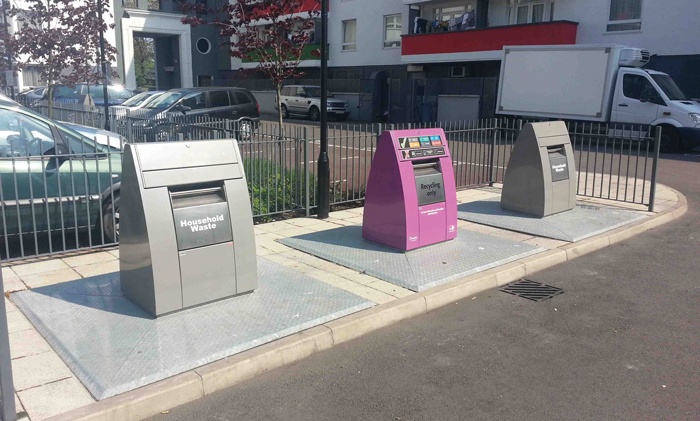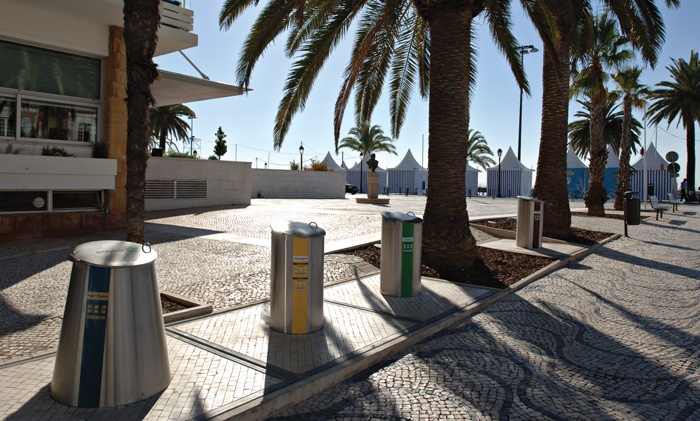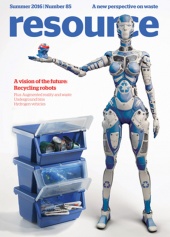Could underground waste collection come to the UK?
Common on the Continent, underground bins are still a relatively rare phenomenon in the UK. Will Simpson digs deep to discover whether that is set to change.

The traditional system of waste and recycling collection that we have in the UK – wheelie bins, boxes or bags collected on a weekly or fortnightly basis – has been so long established that it sometimes feels set in stone. Until recently, few have questioned whether it is the best or most efficient way to organise a recycling service.
But in recent years, a new system has been making inroads. Underground waste and recycling systems have been common on the Continent since the early ’90s, and we are starting to see them emerge in the UK – particularly on new-build estates where there is limited space for bins and waste trucks find it difficult to manoeuvre.
The North West Cambridge development is just one that has decided to go down this route. This is an ambitious project that, when it is finally completed in the next decade or so, will provide residential accommodation for both the university and private sector in 3,000 homes, as well as commercial and community facilities. “A large part of the decision to go for underground is their greater capacity”, reveals Brian Nearney, Commercial Director of the development. “The ones that we are installing are five cubic metres. We can get more segregated waste into the three streams that we’re collecting there.”
That increased capacity means that bins, which will be for general household waste, mixed recyclables, and paper (including a separate compartment for batteries in the paper units), don’t have to be emptied on a strict weekly or fortnightly basis. Instead, collections can be made exactly when the bins are nearing their capacity due to the monitoring system that each one is set to contain. “We’re looking at [an] arrangement that will send a signal to the local authority to let them know which bins are near full capacity. It means they can be more targeted in their collection, which will in turn lead to a reduction in CO2 emissions.”
The Portuguese firm Sotkon are the providers of the 500 underground systems that Cambridge is installing in the development’s first phase. “I know in the UK you have a different recycling culture”, suggests Sotkon CEO Hélder Barbosa. “Door-to-door collections have been a part of British life for a long time, and perhaps that is why underground systems have been slow to take off there.” The Sotkon underground system is simple in its construction – a concrete bunker, a plastic or metallic heavy-duty container, and a surface entry point receptacle that looks like a conventional street waste bin, mounted on a paved platform which covers the main underground container.

North West Cambridge is far from the first in the UK to use them, though – that accolade goes to the Poplar HARCA (Housing and Regeneration Community Association) development in Tower Hamlets, a housing association that took over the running of a series of council estates in the late ’90s and rebuilt much of their infrastructure. As Suzanne Wolfe, HARCA’s Assistant Director of Technical Resources, explains, increasing recycling was only one reason for going underground. “There was also a will to radically uplift the outdoor environment on the estates. The first ones we put them on were typical ex-council blocks – concrete, very neglected environments. We thought it was [an] important contributor to people’s wellbeing to create more and better quality green spaces.
“Residents do appreciate the difference it makes – it’s an end to smelly bins around the place and visibly better. If there had been concerns in the beginning around things like ability to transport refuse to an underground system, that was very easily allayed once the schemes were in. Typically, you move away from the black sack and end up with smaller packages big enough to go into the aperture without any difficulties, which makes things more portable. There were adaptations to be made, but people made those transitions, and we certainly don’t have complaints about them now.”
However, whether or not underground systems actually lead to improved recycling rates seems difficult to ascertain – because rates are calculated across a whole borough, there are no separate figures for the Poplar development. A case study produced by Sotkon into a system it supplied to the Portuguese municipality of Cascais suggests that tonnages for all the streams its underground system collect – paper and cardboard, plastic, and metal and glass – fell between 2009 and 2014, although the firm points out that the fall cannot be attributed to the system or containers as the financial crises had led to lower consumption rates and therefore to lower recycling rates.

For a local authority looking to install such a system, there also has to be an investment in specialist collection trucks. “We’re looking at a specific vehicle that has a crane on the rear of the truck”, says Nearney. “The crane hook ties on the top part of the receptacle and [the] lid flips up. The hook that the crane is attached to lifts the whole of the five cubic metre bin out of the ground, swings it around, and opens up the chute at the bottom of the bin to empty that into the bin lorry itself.”
This upfront capital cost remains the major snag with underground recycling. However, Joe Watson, Business Development Manager of Plastic Omnium, the French multinational that supplies the underground systems for Poplar HARCA, suggests that, over the long term, that initial cost is recouped. “The capital investment is obviously a lot more than a traditional system, but by the time you look at the reduction in the amount of collections, the fact that you don’t have to repair burnt- out bins, you don’t have the ongoing cost of vermin control... we’ve done some calculations, and over a 10-year period, an underground system is very much comparable with what you would pay for a traditional system. Eventually, they make their money back.”
 This article was taken from Issue 85
This article was taken from Issue 85Watson is adamant that underground can be used for all the major recycling streams currently collected from UK kerbsides – indeed, Plastic Omnium is looking to integrate food waste into the Poplar development if residents are supportive. The company’s Portuguese counterpart, though, is cautious about the issue of maintenance. “If they are cleaned regularly, there is no reason why underground systems cannot still be like new after 10 years”, says Barbosa. “But I know some of our competitors have a hydraulic solution to open the systems, which then need[s] oil and technical skills to make the maintenance work – which increases the cost. So it really depends on the local authority and the system they have in place.” For its part, Sotkon says the low maintenance on its systems means the payback period is three to five years.
In any case, it’s unlikely that underground will completely replace traditional street collections in the UK anytime soon. But with the government having recently announced plans to rebuild many of the ‘worst’ estates in the UK, and with many local authorities looking to renovate existing council stock, it seems certain their presence will only increase over the next 10 to 20 years. “We’re talking to a lot of developers at the moment in places like Newham, Bexley, Greenwich and Camden”, reveals Watson. “Yes, it’s been a slow burner, but I believe it’s going to take off now.”
Certainly, the underground pioneers at Tower Hamlets seem to have no regrets. “Personally, I would like to get all of our waste underground”, says Wolfe. “You no longer have hundreds of bins dotted around... and destroying the visual aesthetic. For us, it’s definitely been the right move.”







